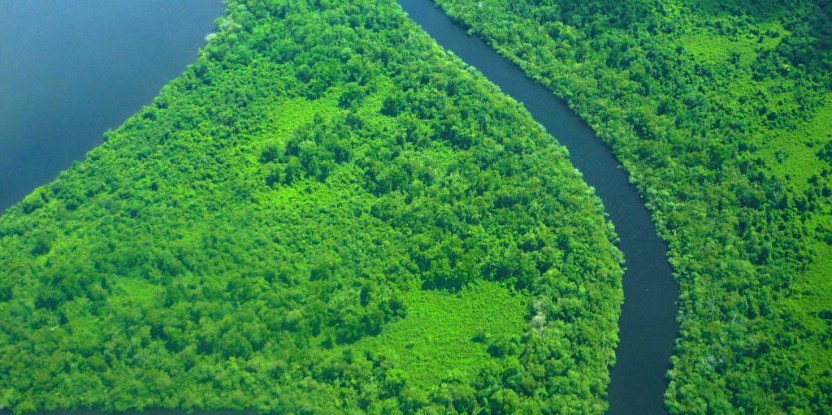
As REDD+ has evolved and expanded, numerous opportunities, synergies and challenges have emerged, particularly with respect to tenure and financing. CIFOR’s ongoing Global Comparative Study on REDD+ offers lessons for achieving the transformational change necessary to make the framework succeed. These are issues that transcend the forestry sector and resolving them demands coordination across multiple sectors and policy integration across multiple scales.
Since its inception, REDD+, or Reducing Emissions from Deforestation and Forest Degradation, has evolved from a tool for climate change mitigation based on carbon storage into a complex, multifaceted framework operating across multiple governance levels.
Its mission has similarly expanded to encompass a potential overload of objectives. The REDD+ Framework within the UNFCCC draws together human rights (with particular emphasis on the rights of indigenous peoples), biodiversity conservation, stronger governance in developing countries, and, most recently, acceptance of carbon and non-carbon benefits, alternative approaches and linkages with adaptation. Similarly, the finance discussion has moved beyond carbon markets and offsetting to include multiple sources of finance.
As research from CIFOR’s Global Comparative Study on REDD+ shows, this evolution of REDD+ has generated a range of opportunities and synergistic approaches across these multiple objectives. At the same time, challenges for its implementation have emerged: close alliances between large-scale business and state sectors, without tackling the underlying causes of deforestation; the need for more certainty about finance; and significant and complex tenure issues.
As REDD+ continues to evolve and move into the broader landscape, the evidence suggests that success will require reform beyond the forestry sector to include tenure and other aspects of governance. REDD+ practitioners will need to seize the opportunities and confront the challenges that arise as they integrate efforts across multiple scales and increase coordination across sectors and landscapes.
THE NEED FOR CLARITY OF TENURE
At the subnational level, REDD+ is unfolding in an environment where existing tenure regimes create challenges for its implementation. For REDD+ to succeed, it is necessary to identify not only those in the community who will hold the legal right to the anticipated stream of REDD+ benefits, but also those who will bear the responsibility for ensuring the completion of REDD+ activities. Moreover, REDD+ stakeholders – community members and proponents alike – may require enforceable rights of exclusion to protect REDD+ activities against outside claims, such as claims from those seeking to convert forests to non-forest uses.
Yet assuring tenure clarity and security for local stakeholders is difficult in many tropical developing countries, because the state has formal ownership over vast areas of the forest estate and it often remains unclear what legally constitutes ‘forests’ outside this estate. Furthermore, governments’ positions on customary claims and formalization of access or ownership rights may not yet be aligned with efforts to establish a community forestry foundation for REDD+. These landscapes are also often characterized by power imbalances between large-scale agribusinesses and communities at the forest frontier. Under these conditions, many REDD+ proponents view tenure as their priority challenge, even more so than the (currently) disadvantageous economics of REDD+.
If REDD+ is to fulfill its promise, proponents must develop an in-depth understanding of the landscape in which they are operating. They must understand the wider context of land-use planning around their sites, and the dynamics of unplanned migrations, spontaneous colonization, appropriations and competing land claims, all of which might undermine their efforts. They must be fully apprised of the dynamics of developments not only in agriculture and forestry, but also in mining and infrastructure. They must also understand the elements of governance across scales that can either undermine them.
BUILDING ON EXISTING POLICIES AND INSTITUTIONS
In a national context, CIFOR’s Global Comparative Study on REDD+ has found that REDD+ processes move towards transformational change more rapidly in countries where related policy changes have already paved the way for them. For example, the impetus behind the marked drop in Brazil’s deforestation rate dates back to 2005, well before REDD+, with command-and-control policies and commodity-chain-focused interventions including livestock and soy boycotts.
Dozens of REDD+ initiatives are under way at the ‘jurisdictional’ scale, that is, across a formal governance unit such as a state, province, municipality or district
CIFOR’s analyses of successful REDD+ policies have identified the need for a combination of features within a country. First, countries that have already initiated changes to their institutions have made greater progress in designing REDD+, so long as the pressure on forest resources is high, or effective forest legislation, policy and governance are also in place. Second, a sense of national ownership and the presence of coalitions for transformational change are also important – but are effective only in an enabling institutional setting.
At the same time, some of the more successful countries are working towards changing their national land management and tenure policies which can support the implementation of REDD+.
For example, Brazil’s Rural Environmental Registry (CAR) requires that at least 80 per cent of private land be under forest cover (in accordance with the Brazilian Forest Code), and is a prerequisite to land titling through the national Terra Legal programme. For this reason, proponents in Brazil work closely with government as a key partner in promoting environmental compliance and clarifying tenure arrangements. Evidence shows, however, that the use of the registry alone has not led to reduced deforestation in the states of Pará and Mato Grosso, and implementation challenges for Terra Legal are yet to be fully overcome.
Proponents in Indonesia employ functionally similar instruments to assist in enforcing rights of exclusion. Proponents are using the relatively new hutan desa (village forest) category of tenure to claim formal management rights for communities, thereby building a bulwark against counter-claims by oil palm concessionaires. Similarly, REDD+ proponents are using the Ecosystem Restoration Concession (ERC) to consolidate tenure rights over forests targeted for protection, over and against the plans of competing land uses. In both cases, however, proponents report that bureaucratic procedures remain a challenge.
JURISDICTIONAL LESSONS
Dozens of REDD+ initiatives are under way at the ‘jurisdictional’ scale, that is, across a formal governance unit such as a state, province, municipality or district. In theory, advantages of this approach are the leverage of state authority; coordination among branches of government and across sectors (e.g. agriculture, forestry, infrastructure, mining, social welfare) and scales (local to national levels); access to at least low-level operational funding; and greater potential to address leakage.
Certifying organizations have taken note of these advantages. The Verified Carbon Standard (VCS) has developed a Jurisdictional and Nested REDD+ framework for accounting and crediting at national and subnational scales, and CCBA and CARE have created the REDD+ Social and Environmental Safeguards Initiative for jurisdictional REDD+ programs that perform well in achieving social and biodiversity goals.
Among the limitations of jurisdictional REDD+ is that, despite involving various sectors, it does not resolve the competing interests between them. Furthermore, it requires a large and durable source of funding – which usually exceeds state fiscal resources – and importantly, it is vulnerable to electoral politics, as a change in governorship can stall REDD+ progress.
One example is Acre’s State System of Incentives for Environmental Services (SISA) in Brazil, widely seen as a global model of jurisdictional REDD+ and a leader in bottom-up innovation for low-emissions rural development. Unique for having piloted VCS in a jurisdictional REDD+ framework, SISA has strongly influenced other Amazonian states. An on-going challenge for SISA is its search for funding alternatives to its heavy reliance on international donations, as it is not yet able to rely on the marketing of forest carbon offsets.
Another example is the Governors’ Climate and Forest Task Force (GCF), a global network of 26 member states across 7 countries (www.gcftaskforce.org). The GCF is a pioneer of jurisdictional REDD+ and provides a forum for communication and coordination among its members. The Rio Branco Declaration of August 2014 commits GCF member states and provinces to an 80 percent reduction in deforestation by 2020, with support from the international community in the form of performance-based funding. The Declaration also commits the governors to allocate a substantial share of the stream of economic benefits to forest-dependent communities and indigenous peoples.
PRIVATE CORPORATE SECTOR COMMITMENTS
Private sector corporations are making moves to remove deforestation from commodity value chains. Globalised trade and investment in agricultural commodities such as palm oil, beef, soya, pulp and paper, and rubber have grown significantly over the past two decades, resulting in continued high rates of deforestation in many developing countries. At the same time, consumer countries have become increasingly aware of the impacts of imported food, non-food commodities and manufactured goods on tropical deforestation.
One commodity in particular – palm oil – has been subject to heavy criticism by advocacy NGOs over the past decade because of links to deforestation. Persistent pressure and social media coverage by organisations such as Greenpeace, WWF and the Forest Peoples Programme have been instrumental in shaping growing consumer demand for sustainably produced commodities. After initial pledges by a small number of companies (notably Nestlé, Golden Agri-Resources, Wilmar, Hersheys and Unilever) during 2011–2013, 2014 has witnessed a surge in corporate commitments to zero deforestation in palm oil supply chains, and increasingly with regard to other commodities. For example, Cargill has extended its initial commitment to a ‘No Deforestation, No Peat and No Exploitation’ policy in palm oil production and sourcing to all commodities with effect from 24 September 2014. This groundswell of corporate engagement is manifest in the number of signatories (40) to the recent New York Declaration on Forests Action Statements and Action Plans.
Global and regional scrutiny of corporate practice in agri-business contributed to the establishment of the Roundtable on Sustainable Palm Oil in 2004 (other multi-stakeholder platforms have followed with regard to soy and biofuels, among others), the Norwegian Sovereign Wealth Fund decision to divest from 23 palm oil companies in 2013, a suspension in 2012 of lending to the palm oil sector by the International Finance Corporation, and changes in lending practices by both banks and investors.
FINANCING SUSTAINABLE LANDSCAPES
Financing – particularly transfers of funds and technology from developed to developing countries – has always been one of the most controversial issues in UNFCCC negotiations. The unofficial consensus is that developed countries must mobilize US$100 billion in climate finance each year by 2020. The anticipated recipient of these funds is the Green Climate Fund, which seeks to secure between US$10 billion and 15 billion by the end of 2014.
By comparison, domestic and international subsidies for fossil fuels totaled more than US$500 billion globally in 2011, and remain a key obstacle to investing in low-carbon and climate-resilient economies.
To date, climate change mitigation efforts (including REDD+) have received the bulk of the funding – an estimated US$350 billion (both public and private sector finance) compared with just US$14 billion for adaptation. As a result of this imbalance, adaptation has become more prominent in UNFCCC negotiations over the new climate agreement.
Furthermore, a recent global analysis of 115 REDD+ demonstration projects reveals a concentration of finance in large emerging and resource-rich countries. For example, 19 of the 30 projects in Asia – covering a total area of almost 10.5 million hectares – are in Indonesia, one of eight countries targeted in the region.
Meeting the target of US$100 billion a year will require a transformation in the scale and pace of public and private sector financing for both mitigation and adaptation, as well as broader, more complex transitions to low-carbon economies. New ways of packaging and delivering finance are necessary if the funds are to reach the rural and urban poor. The OECD, for example, specifies the need “to use limited public finance to target areas where private funding will not be available or sufficient, e.g. adaptation and REDD+.”
Governments, donors and non-governmental and research organisations still have much to learn about working with corporate actors
REDD+ financing delivered through the creation of a new asset class has yet to materialise, however. The promise of performance-based funding plays a positive role in achieving REDD+ when it is applied in countries that lead the process themselves and have strong national ownership. Where the sense of ownership is low – where donors are leading the process – the promise of performance-based foreign financial funds appears to be irrelevant.
The private sector is expected to fill the gap in climate change financing. Other benefits of engaging the private sector lie in the potential to harness its technical capacity for achieving climate change mitigation and adaptation and to mobilize larger investments in sustainable landscapes.
However, the current global financial system is not designed to service rural economies in developing countries. Rural producers face major agricultural risks in the form of natural disasters (extreme weather events and disease) and in production, technology, financing, laws and policy, and price volatility (inputs and outputs). These risks potentially decrease producers’ income through their negative impacts on yield, price, assets and livelihoods, thus increasing the probability of default. The compound problems of insecure land rights and a lack of collateral make agricultural, agroforestry and forestry loans in developing countries high-risk investments.
CONCLUSION
REDD+ has the potential to play a significant role in achieving sustainable development and climate change mitigation and adaptation. However, its success depends on first achieving transformational change, namely major shifts in discourses, power relations and economic incentives for the value of standing forests. Resolving these issues requires coordination and policy integration across multiple sectors and scales.
REDD+ proponents’ perception of tenure as their priority challenge should be taken seriously, as should the need for REDD+ proponents to understand the landscape in which they are operating, as REDD+ activities take place within a context of broader development objectives.
As countries move towards implementation, the emergence of jurisdictional REDD+ initiatives is encouraging, given the associated advantages of coordination among branches of government, across sectors and across scales. Countries could benefit greatly from the finding that REDD+ processes will move towards transformational change more rapidly when relevant policy pathways and legal frameworks are already in place. The multitude of international initiatives and the continued development of the REDD+ effort appear to be paying off in commitments and actions on a range of levels.
Nevertheless, financing remains problematic. Governments, donors and non-governmental and research organisations still have much to learn about working with corporate actors (including institutional investors), and about identifying ways to encourage private investments in what are still often perceived as ‘high-risk and low-income’ emerging markets.
Recent commitments from the private sector represent an important first step along the long and winding road to sustainability. The governance contexts in each country where such commodities are produced and/or sourced will significantly influence the extent to which companies can translate their pledges into tangible actions. Furthermore, it remains unclear how much – and how quickly – corporate actors will be able to instigate changes in their production systems and supply chains, and ultimately be in a position to provide credible and independent evidence of progress. Reaching that stage includes mediating unresolved land conflicts between companies and communities.
Editor’s Note: This article originally appeared on the website Climate Action.
We want you to share Forests News content, which is licensed under Creative Commons Attribution-NonCommercial-ShareAlike 4.0 International (CC BY-NC-SA 4.0). This means you are free to redistribute our material for non-commercial purposes. All we ask is that you give Forests News appropriate credit and link to the original Forests News content, indicate if changes were made, and distribute your contributions under the same Creative Commons license. You must notify Forests News if you repost, reprint or reuse our materials by contacting forestsnews@cifor-icraf.org.


